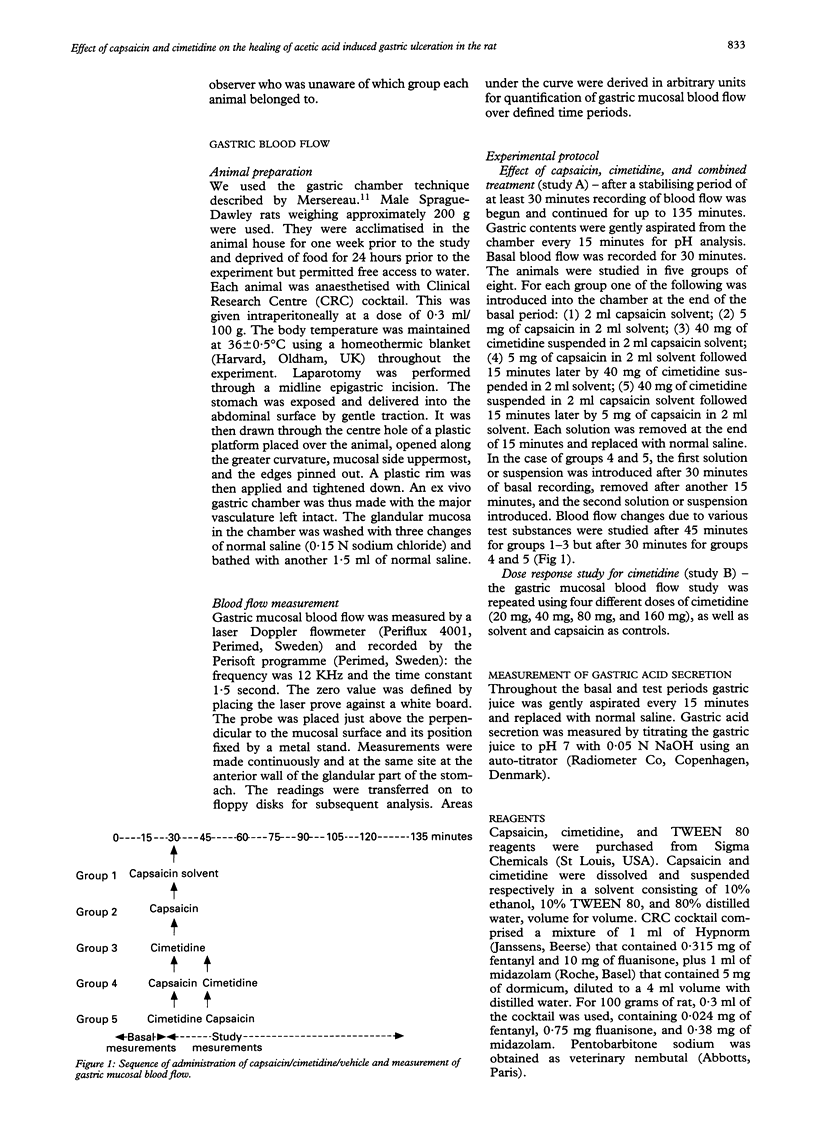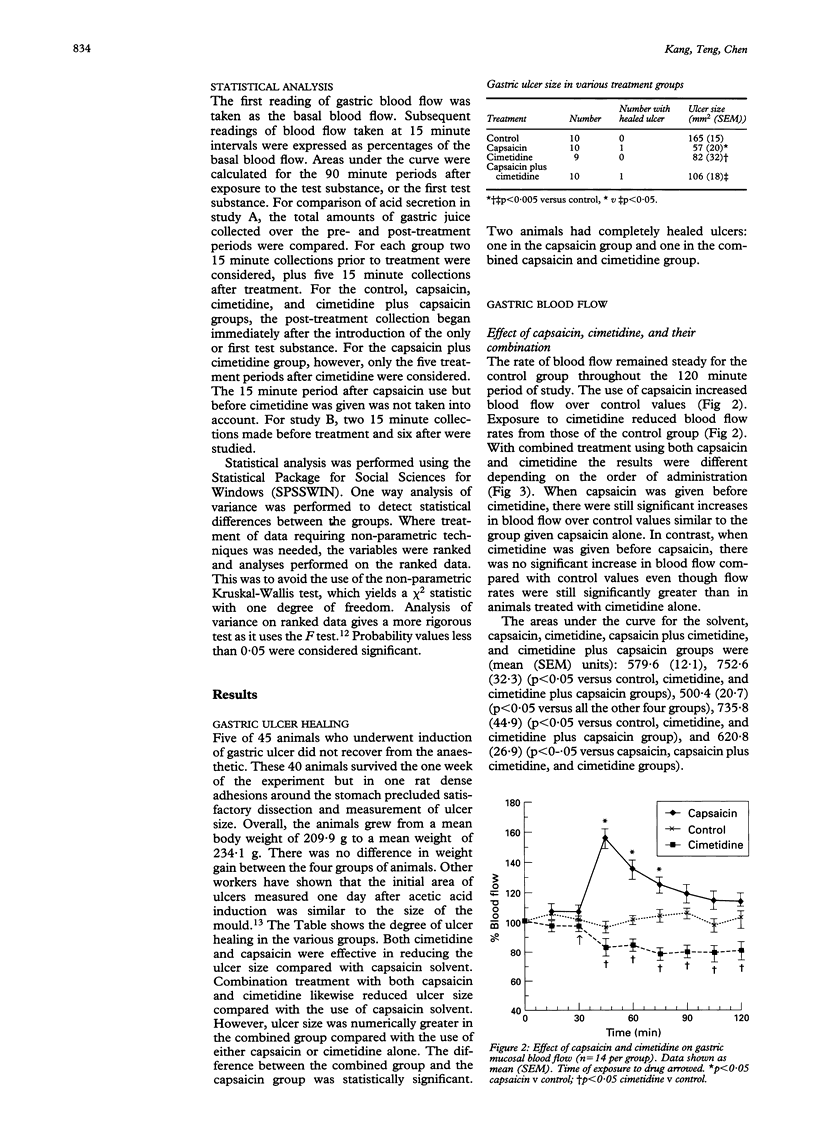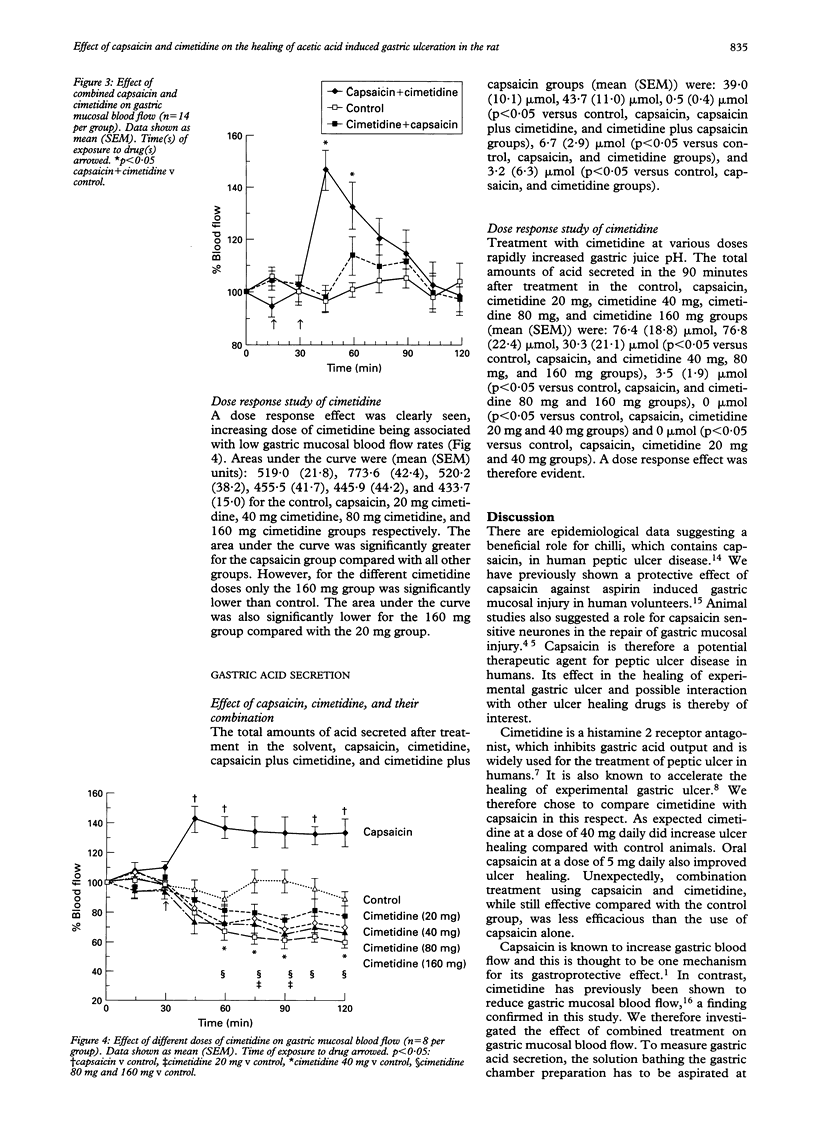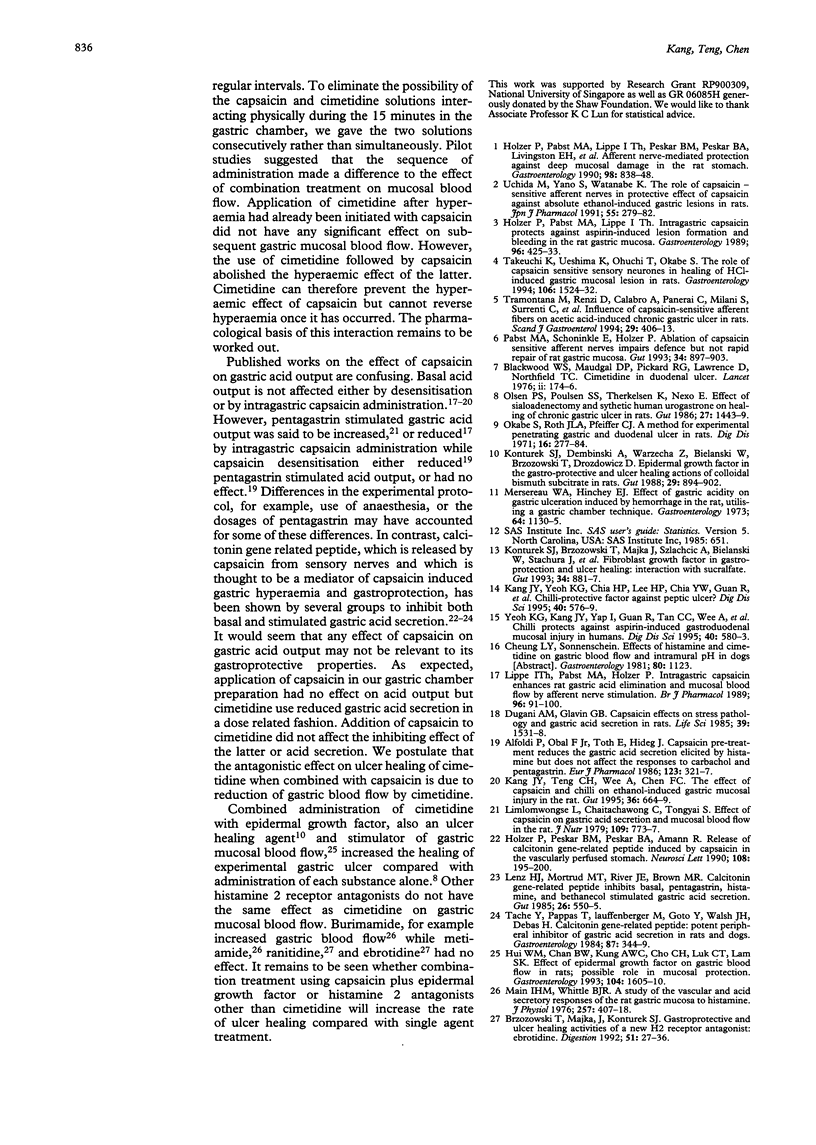Abstract
BACKGROUND: Capsaicin protects the gastric mucosa against experimental injury while capsaicin desensitisation reduces the rate of gastric ulcer healing. The effect of exogenous capsaicin on gastric ulcer healing has not to date been reported. AIM/METHOD: To investigate the effect of capsaicin, cimetidine, and in combination, given intragastrically in the healing of acetic acid induced chronic gastric ulcer in the rat. Treatment started immediately after ulcer induction. RESULTS: At the end of one week, capsaicin, cimetidine, and in combination increased ulcer healing but the effect of combined treatment was less than that of capsaicin alone. In an in vivo gastric chamber preparation, capsaicin increased, while cimetidine decreased, gastric mucosal blood flow measured by laser Doppler flowmetry. A dose response effect in reduction of gastric mucosal blood flow could be demonstrated for cimetidine. The gastric hyperaemic effect of capsaicin was blunted by prior administration of cimetidine. In contrast, capsaicin had no effect on gastric acid secretion and its addition to cimetidine did not affect the acid suppressant effect of the latter. CONCLUSIONS: Capsaicin promotes the healing of acetic acid induced gastric ulcer, probably by its gastric hyperaemic effect. Although cimetidine also promotes ulcer healing due to its inhibitory effect on acid secretion it may have an antagonistic effect on the gastric ulcer healing effect of capsaicin by virtue of inhibition of gastric hyperaemia.
Full text
PDF




Selected References
These references are in PubMed. This may not be the complete list of references from this article.
- Alföldi P., Obál F., Jr, Tóth E., Hideg J. Capsaicin pretreatment reduces the gastric acid secretion elicited by histamine but does not affect the responses to carbachol and pentagastrin. Eur J Pharmacol. 1986 Apr 29;123(3):321–327. doi: 10.1016/0014-2999(86)90704-1. [DOI] [PubMed] [Google Scholar]
- Blackwood W. S., Maudgal D. P., Pickard R. G., Lawrence D., Northfield T. C. Cimetidine in duodenal ulcer. Controlled trial. Lancet. 1976 Jul 24;2(7978):174–176. doi: 10.1016/s0140-6736(76)92347-3. [DOI] [PubMed] [Google Scholar]
- Brzozowski T., Majka J., Konturek S. J. Gastroprotective and ulcer-healing activities of a new H2-receptor antagonist: ebrotidine. Digestion. 1992;51(1):27–36. doi: 10.1159/000200872. [DOI] [PubMed] [Google Scholar]
- Dugani A. M., Glavin G. B. Capsaicin effects on stress pathology and gastric acid secretion in rats. Life Sci. 1986 Oct 27;39(17):1531–1538. doi: 10.1016/0024-3205(86)90383-8. [DOI] [PubMed] [Google Scholar]
- Holzer P., Pabst M. A., Lippe I. T., Peskar B. M., Peskar B. A., Livingston E. H., Guth P. H. Afferent nerve-mediated protection against deep mucosal damage in the rat stomach. Gastroenterology. 1990 Apr;98(4):838–848. doi: 10.1016/0016-5085(90)90005-l. [DOI] [PubMed] [Google Scholar]
- Holzer P., Peskar B. M., Peskar B. A., Amann R. Release of calcitonin gene-related peptide induced by capsaicin in the vascularly perfused rat stomach. Neurosci Lett. 1990 Jan 1;108(1-2):195–200. doi: 10.1016/0304-3940(90)90730-w. [DOI] [PubMed] [Google Scholar]
- Hui W. M., Chen B. W., Kung A. W., Cho C. H., Luk C. T., Lam S. K. Effect of epidermal growth factor on gastric blood flow in rats: possible role in mucosal protection. Gastroenterology. 1993 Jun;104(6):1605–1610. doi: 10.1016/0016-5085(93)90635-p. [DOI] [PubMed] [Google Scholar]
- Kang J. Y., Teng C. H., Wee A., Chen F. C. Effect of capsaicin and chilli on ethanol induced gastric mucosal injury in the rat. Gut. 1995 May;36(5):664–669. doi: 10.1136/gut.36.5.664. [DOI] [PMC free article] [PubMed] [Google Scholar]
- Kang J. Y., Yeoh K. G., Chia H. P., Lee H. P., Chia Y. W., Guan R., Yap I. Chili--protective factor against peptic ulcer? Dig Dis Sci. 1995 Mar;40(3):576–579. doi: 10.1007/BF02064373. [DOI] [PubMed] [Google Scholar]
- Konturek S. J., Brzozowski T., Majka J., Szlachcic A., Bielanski W., Stachura J., Otto W. Fibroblast growth factor in gastroprotection and ulcer healing: interaction with sucralfate. Gut. 1993 Jul;34(7):881–887. doi: 10.1136/gut.34.7.881. [DOI] [PMC free article] [PubMed] [Google Scholar]
- Konturek S. J., Dembinski A., Warzecha Z., Bielanski W., Brzozowski T., Drozdowicz D. Epidermal growth factor (EGF) in the gastroprotective and ulcer healing actions of colloidal bismuth subcitrate (De-Nol) in rats. Gut. 1988 Jul;29(7):894–902. doi: 10.1136/gut.29.7.894. [DOI] [PMC free article] [PubMed] [Google Scholar]
- Lenz H. J., Mortrud M. T., Rivier J. E., Brown M. R. Calcitonin gene related peptide inhibits basal, pentagastrin, histamine, and bethanecol stimulated gastric acid secretion. Gut. 1985 Jun;26(6):550–555. doi: 10.1136/gut.26.6.550. [DOI] [PMC free article] [PubMed] [Google Scholar]
- Limlomwongse L., Chaitauchawong C., Tongyai S. Effect of capsaicin on gastric acid secretion and mucosal blood flow in the rat. J Nutr. 1979 May;109(5):773–777. doi: 10.1093/jn/109.5.773. [DOI] [PubMed] [Google Scholar]
- Lippe I. T., Pabst M. A., Holzer P. Intragastric capsaicin enhances rat gastric acid elimination and mucosal blood flow by afferent nerve stimulation. Br J Pharmacol. 1989 Jan;96(1):91–100. doi: 10.1111/j.1476-5381.1989.tb11788.x. [DOI] [PMC free article] [PubMed] [Google Scholar]
- Main I. H., Whittle B. J. A study of the vascular and acid-secretory responses of the rat gastric mucosa to histamine. J Physiol. 1976 May;257(2):407–418. doi: 10.1113/jphysiol.1976.sp011375. [DOI] [PMC free article] [PubMed] [Google Scholar]
- Mersereau W. A., Hinchey E. J. Effect of gastric acidity on gastric ulceration induced by hemorrhage in the rat, utilizing a gastric chamber technique. Gastroenterology. 1973 Jun;64(6):1130–1135. [PubMed] [Google Scholar]
- Okabe S., Roth J. L., Pfeiffer C. J. A method for experimental, penetrating gastric and duodenal ulcers in rats. Observations on normal healing. Am J Dig Dis. 1971 Mar;16(3):277–284. doi: 10.1007/BF02235252. [DOI] [PubMed] [Google Scholar]
- Olsen P. S., Poulsen S. S., Therkelsen K., Nexø E. Effect of sialoadenectomy and synthetic human urogastrone on healing of chronic gastric ulcers in rats. Gut. 1986 Dec;27(12):1443–1449. doi: 10.1136/gut.27.12.1443. [DOI] [PMC free article] [PubMed] [Google Scholar]
- Pabst M. A., Schöninkle E., Holzer P. Ablation of capsaicin sensitive afferent nerves impairs defence but not rapid repair of rat gastric mucosa. Gut. 1993 Jul;34(7):897–903. doi: 10.1136/gut.34.7.897. [DOI] [PMC free article] [PubMed] [Google Scholar]
- Taché Y., Pappas T., Lauffenburger M., Goto Y., Walsh J. H., Debas H. Calcitonin gene-related peptide: potent peripheral inhibitor of gastric acid secretion in rats and dogs. Gastroenterology. 1984 Aug;87(2):344–349. [PubMed] [Google Scholar]
- Takeuchi K., Ueshima K., Ohuchi T., Okabe S. The role of capsaicin-sensitive sensory neurons in healing of HCl-induced gastric mucosal lesions in rats. Gastroenterology. 1994 Jun;106(6):1524–1532. doi: 10.1016/0016-5085(94)90406-5. [DOI] [PubMed] [Google Scholar]
- Tramontana M., Renzi D., Calabrò A., Panerai C., Milani S., Surrenti C., Evangelista S. Influence of capsaicin-sensitive afferent fibers on acetic acid-induced chronic gastric ulcers in rats. Scand J Gastroenterol. 1994 May;29(5):406–413. doi: 10.3109/00365529409096830. [DOI] [PubMed] [Google Scholar]
- Yeoh K. G., Kang J. Y., Yap I., Guan R., Tan C. C., Wee A., Teng C. H. Chili protects against aspirin-induced gastroduodenal mucosal injury in humans. Dig Dis Sci. 1995 Mar;40(3):580–583. doi: 10.1007/BF02064374. [DOI] [PubMed] [Google Scholar]


